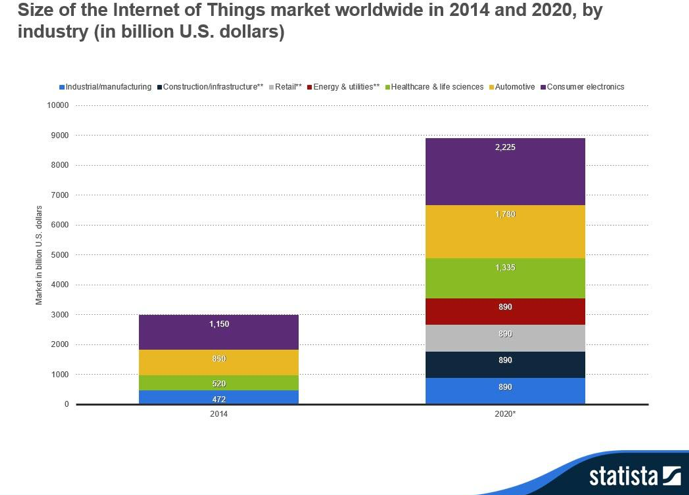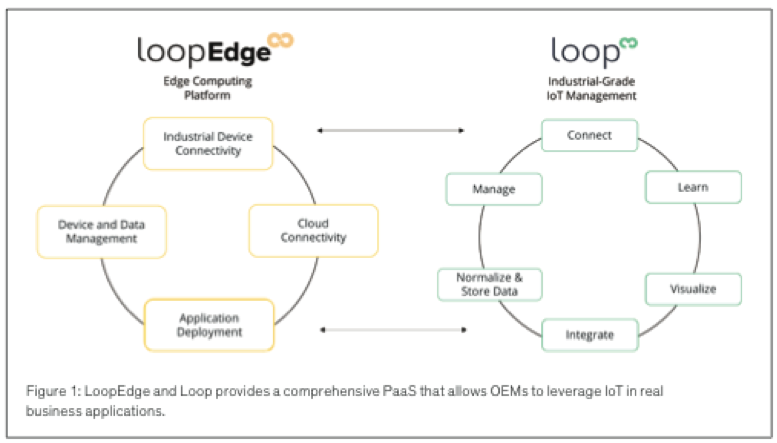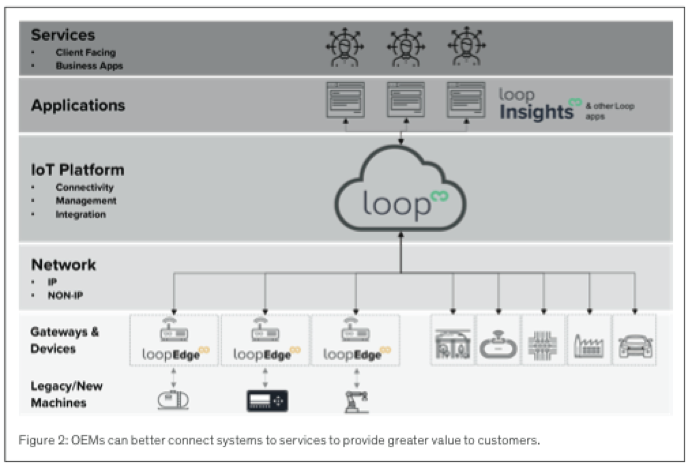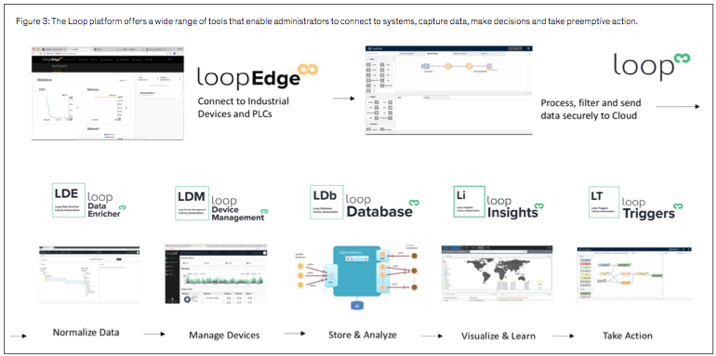The Ideal IIoT Solution For OEMs
The Internet of Things (IoT) represents an undeniable business opportunity to OEMs developing industrial equipment and machinery. Just about every industry is digitizing, and industrial equipment is no different. While customers purchase equipment to perform a specific task, connecting the asset can help them make more money and improve efficiencies for the asset’s limited lifecycle. Forward-thinking customers are going even further, enabling machine learning and artificial intelligence, which gives their machines human-like behaviors and the ability to optimize cycle times and material use very quickly.
Global spending on industrial manufacturing is predicted to increase to $890B by 2020 (Figure 1). Industrial OEMs including equipment makers and large component manufacturers can capture more of this market by integrating IoT solutions that will help customers automate data capture from any number of connected machines or Edge devices, aggregate that data to the cloud and apply analytics to identify trends and make business decisions.

Figure 1: Statista predicts the Industrial IoT market worldwide will grow from $472B in 2014 to $890B in 2020
Advanced Industrial IoT solutions look at assets from the user perspective and give manufacturers the ability to remotely monitor equipment, predict operating failures, and preempt issues through preventative maintenance to increase customer uptime. In the end customers have more data, better data, and better business intelligence – all with the potential to deliver higher margins for bottom-line profitability.
However, implementing IoT technology effectively has not been easy for OEMs who are dealing with both new and existing infrastructure, both of which must be data-ready and connected. Industrial OEMs have focused their engineering efforts toward understanding their core market and delivering value. Typically, developing a reliable and secure IoT platform with end-to-end connectivity between devices and the cloud is beyond their expertise. While OEMs could invest in building IoT expertise in-house, such a delay to market would place them behind more agile competitors.
As more customers digitize and realize the value they can extract from machines to improve service efficiency, enhance product features, and add new services, the more demand there is for Industrial IoT solutions to enable those capabilities. Luckily, OEMs can take advantage of an extensive ecosystem of technology companies with solutions including wireless sensors, gateways, cloud platforms, and a full range of data collection and analytics applications. These types of Industrial IoT solutions are not just concepts anymore – they are real, working solutions, and industrial OEMs can introduce IoT capabilities into their existing product lines quickly and with minimal development investment.
The Integration Challenge
With so many options, the challenge remaining for OEMs is to integrate best-in-class solutions quickly and reliably. For example, there are a myriad of PLCs, controllers and sensors available to control machines and track variables like temperature, pressure, or strain. IoT systems need to be able to connect to a variety of Edge devices with proprietary protocols and data formats. They also need to be able to secure communications to these devices, even for legacy equipment never designed to connect to the Internet. Last but not least, a reliable management system must be in place that can scale to potentially hundreds of thousands of devices throughout the world, depending upon the application.
Litmus Automation helps OEMs reduce the complexity of developing IoT systems and solutions with its Edge and Cloud platforms, LoopEdge and Loop. Loop enables OEMs to safely manage and connect any type of device or machine to the Internet and integrate the data collected in real-time with any software application including ERP, database, big data analytics, and visualization tools.
LoopEdge and Loop, and their accompanying ecosystem of applications, provide a comprehensive Platform-as-a-Service (PaaS) that allows OEMs to leverage IoT in business applications (see Figure 2). Loop also includes an extensive device management suite for deploying and monitoring IoT systems, while LoopEdge provides an Industrial IoT Marketplace at the Edge to seamlessly connect nearly all industrial devices and systems available today to a multitude of applications that can make sense of the data in a matter of minutes.

With the LoopEdge platform, OEMs can significantly accelerate their ability to implement IoT-based capabilities. LoopEdge not only provides Edge device connectivity that runs on any IP network, but also gives OEMs and their customers access to an extensive marketplace of applications. This enables OEMs to connect systems to the services they need to provide greater value to their customers (see Figure 3).

Legacy Device Support
Connecting to the wide variety of legacy or IoT-based devices requires a device-agnostic/network-agnostic platform that can accommodate the different protocols and PLCs used today and in the future. Litmus Automation addresses this challenge by providing an extensive portfolio of drivers that enables out-of-the-box connectivity to a wide range of industrial systems. Loop Edge is able to act as a universal remote, so to speak: administrators can point to a device and LoopEdge will resolve the proper connection.
Flexibility is essential for OEMs embracing the industrial IoT market. Traditionally, industrial automation has been developed with proprietary and application-specific implementations. With the LoopEdge platform, devices can be connected across all controllers and machines, allowing OEMs to utilize nearly any sensor and protocol and take a global approach to Industrial IoT. In addition, Loop is flexible enough to connect to both new and legacy devices so that every industrial system can be connected to the cloud.
Security
Most industrial machines were not designed to connect to the Internet and therefore be exposed over an open network. As a result, they do not have the proper security in place to protect data from being stolen or equipment from being hacked. Many systems are also not able to talk to the cloud or support bidirectional communications.
Loop allows data to be secured using standardized, enterprise-class security protocols and mechanisms, including managing SSL certificates and keys for all connected devices. OEMs can authenticate devices and encrypt data transport end to end, from devices/assets all the way out to the cloud. They can also ensure that devices are kept up to date with the latest security enhancements. For the greatest flexibility, LoopEdge automatically adjusts connect speeds for legacy systems and enables systems to use over-the-air (OTA) update technology securely.
Management
With the wide variety of sensors, devices, and systems that make up an IoT-based environment, there are serious complexities associated with capturing data and implementing intelligence at the Edge. For example, temperature sensors from different vendors may have their own proprietary data structure and format. LoopEdge automatically converts data coming from these various devices and sensors into a single standard data format based on OMA-IPSO standards to facilitate analytics.
With Loop, OEMs can quickly install, update, and manage applications across a large number of LoopEdge nodes. Administrators have full control over the data collected and how it is stored. They can also optimize and manage complex analytics, anomaly detection and machine learning across all their Edge devices. Loop is even flexible enough to support the use of custom data structures, including metadata, to enable OEMs to implement specialized data structures.
Scale
A key challenge in IoT deployments is operating at scale. Monitoring a single piece of equipment could entail communicating with tens or hundreds of sensors. Therefore, monitoring thousands of pieces of equipment requires a platform that can simplify the management of hundreds of thousands of nodes.
Consider the challenge of maintaining security for a large-scale project. Each Edge device needs its own SSL certificate and security keys. The platform also needs to have mechanisms in place to be able to update SSL certificates over time. Furthermore, updating needs to be automated to reduce the need for time-consuming manual updating.
Loop simplifies management at scale by providing a central portal through which an administrator can access all deployed systems. From this single pane, an administrator can monitor the status of equipment, provision systems, push updates, and even alert customers to potential issues. Since Loop can handle hundreds of thousands of nodes, it can manage all of an OEM’s equipment at customer sites around the world.
Accelerating Design and Deployment
The Loop platform is designed to support OEMs across their entire IoT journey with a wide range of tools that enable administrators to connect to systems, capture data, make decisions and take preemptive action (see Figure 4). The platform is also supported by an application marketplace from Litmus Automation and its partners.

Within the marketplace, OEMs can have their own private offerings, which allows them to provide advanced functionality to their customers. Not only does the marketplace enable OEMs to deliver and manage custom applications at scale, it provides a means for them to monetize functionality. For example, customers could purchase failure detection capabilities for specific systems and assets, all without manual intervention by the OEM. The extensive partner ecosystem built around the LoopEdge and Loop platforms enables Litmus Automation to deliver the additional services that OEMs need in order to achieve global reach with a local touch.
Use Case: OEM Predictive Maintenance and Monitoring
A commercial industrial boiler manufacturer wanted to develop new after-sale revenue streams for equipment with a life span of 40+ years. Using a gateway running LoopEdge, data could be collected from all its various PLCs across different product lines, even those with legacy interfaces. The gateway then securely sent this data to the cloud using LoopCloud where all devices were managed and data and was normalized, stored, and analyzed over time.
With this infrastructure in place, the manufacturer could offer value-added services like predictive maintenance and advanced monitoring. This was achieved by setting data triggers at levels that were analyzed to indicate the machine was likely to fail. When a threshold was met, a lead was automatically generated in the company’s Salesforce CRM for its customer service team to notify the customer that the machine needed service.
The service could be sold at a premium to customers, even for equipment that had been deployed decades ago. In addition, the data collected enabled the manufacturer to improve overall machine reliability and decrease failure costs while at the same time increasing brand awareness and customer loyalty. More about What is Universal automation?
Taking the Next Step to Adopt an Industrial IoT Strategy
With these types of industrial IoT solutions, industrial OEMs can bring better products to market faster while maximizing the efficiency and operating lifetime of deployed equipment. While building an IoT solution is not simple, there are many companies in the IoT ecosystem that can provide the hardware and software needed to take advantage of the cloud and data analytics. With the ability to connect, secure, manage, and scale that is afforded by the LoopEdge and Loop IIoT platforms from Litmus Automation, OEMs can take advantage of best-in-class technology to accelerate building out their IoT environment and bringing more value to their customers faster.
The world’s industrial plants and machines are going digital – there is no escaping it. The question is, how smart and how fast can Industrial IoT solutions be implemented on both aging and new infrastructure? In order to take advantage of the digital transformation payday, OEMs must embrace the latest technology and incorporate a proven, easy-to-use Edge to Cloud platform from Litmus Automation.
![]() This article was written by John Younes, the Co-Founder & Chief Operating Officer at Litmus Automation. He is in charge of operations and growth for the company and draws on considerable experience working with start-ups and early stage companies. He has a Bachelors in Management from University of Western Ontario and a Masters in Management with specialization in Global Entrepreneurship from EM-Lyon.
This article was written by John Younes, the Co-Founder & Chief Operating Officer at Litmus Automation. He is in charge of operations and growth for the company and draws on considerable experience working with start-ups and early stage companies. He has a Bachelors in Management from University of Western Ontario and a Masters in Management with specialization in Global Entrepreneurship from EM-Lyon.



